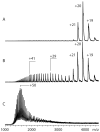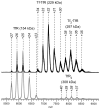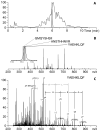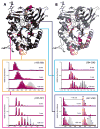Advanced mass spectrometry-based methods for the analysis of conformational integrity of biopharmaceutical products
- PMID: 21542797
- PMCID: PMC3375681
- DOI: 10.2174/138920111798357311
Advanced mass spectrometry-based methods for the analysis of conformational integrity of biopharmaceutical products
Abstract
Mass spectrometry has already become an indispensable tool in the analytical armamentarium of the biopharmaceutical industry, although its current uses are limited to characterization of covalent structure of recombinant protein drugs. However, the scope of applications of mass spectrometry-based methods is beginning to expand to include characterization of the higher order structure and dynamics of biopharmaceutical products, a development which is catalyzed by the recent progress in mass spectrometry-based methods to study higher order protein structure. The two particularly promising methods that are likely to have the most significant and lasting impact in many areas of biopharmaceutical analysis, direct ESI MS and hydrogen/deuterium exchange, are focus of this article.
Figures







Similar articles
-
MS-based conformation analysis of recombinant proteins in design, optimization and development of biopharmaceuticals.Methods. 2018 Jul 15;144:134-151. doi: 10.1016/j.ymeth.2018.04.011. Epub 2018 Apr 18. Methods. 2018. PMID: 29678586 Review.
-
Mass spectrometry-based methods in characterization of the higher order structure of protein therapeutics.J Pharm Biomed Anal. 2020 May 30;184:113169. doi: 10.1016/j.jpba.2020.113169. Epub 2020 Feb 12. J Pharm Biomed Anal. 2020. PMID: 32092629 Free PMC article. Review.
-
Conformation and dynamics of biopharmaceuticals: transition of mass spectrometry-based tools from academe to industry.J Am Soc Mass Spectrom. 2010 Mar;21(3):323-37. doi: 10.1016/j.jasms.2009.10.013. Epub 2009 Oct 29. J Am Soc Mass Spectrom. 2010. PMID: 19963397 Free PMC article.
-
Advances and challenges in analytical characterization of biotechnology products: mass spectrometry-based approaches to study properties and behavior of protein therapeutics.Biotechnol Adv. 2012 Jan-Feb;30(1):210-22. doi: 10.1016/j.biotechadv.2011.05.006. Epub 2011 May 17. Biotechnol Adv. 2012. PMID: 21619926 Free PMC article. Review.
-
Higher order structure characterization of protein therapeutics by hydrogen/deuterium exchange mass spectrometry.Anal Bioanal Chem. 2014 Oct;406(26):6541-58. doi: 10.1007/s00216-014-7924-3. Epub 2014 Jun 20. Anal Bioanal Chem. 2014. PMID: 24948090 Review.
Cited by
-
Mass spectrometry-guided optimization and characterization of a biologically active transferrin-lysozyme model drug conjugate.Mol Pharm. 2013 May 6;10(5):1998-2007. doi: 10.1021/mp400026y. Epub 2013 Apr 10. Mol Pharm. 2013. PMID: 23534953 Free PMC article.
-
Post-production protein stability: trouble beyond the cell factory.Microb Cell Fact. 2011 Aug 1;10:60. doi: 10.1186/1475-2859-10-60. Microb Cell Fact. 2011. PMID: 21806813 Free PMC article.
-
Transferrin as a model system for method development to study structure, dynamics and interactions of metalloproteins using mass spectrometry.Biochim Biophys Acta. 2012 Mar;1820(3):417-26. doi: 10.1016/j.bbagen.2011.06.019. Epub 2011 Jun 25. Biochim Biophys Acta. 2012. PMID: 21726602 Free PMC article. Review.
-
Platform dependencies in bottom-up hydrogen/deuterium exchange mass spectrometry.Mol Cell Proteomics. 2013 Feb;12(2):539-48. doi: 10.1074/mcp.M112.023770. Epub 2012 Nov 28. Mol Cell Proteomics. 2013. PMID: 23197788 Free PMC article.
-
Analytical tools for characterizing biopharmaceuticals and the implications for biosimilars.Nat Rev Drug Discov. 2012 Jun 29;11(7):527-40. doi: 10.1038/nrd3746. Nat Rev Drug Discov. 2012. PMID: 22743980 Free PMC article. Review.
References
-
- Walsh G. Biopharmaceutical benchmarks 2010. Nature Biotechnol. 2010;28:917–294. - PubMed
-
- Lundblad RL. Approaches to the Conformational Analysis of Biopharmaceuticals. In: Lundblad RL, editor. Approaches to the conformational analysis of biopharmaceuticals. Boca Raton: CRC Press/Taylor & Francis; 2010.
-
- Kaltashov IA, Eyles SJ. Studies of biomolecular conformations and conformational dynamics by mass spectrometry. Mass Spectrom Rev. 2002;21:37–71. - PubMed
-
- Zhang Z, Pan H, Chen X. Mass spectrometry for structural characterization of therapeutic antibodies. Mass Spectrom Rev. 2009;28:147–176. - PubMed
-
- Srebalus-Barnes CA, Lim A. Applications of mass spectrometry for the structural characterization of recombinant protein pharmaceuticals. Mass Spectrom Rev. 2007;26:370–388. - PubMed
Publication types
MeSH terms
Substances
Grants and funding
LinkOut - more resources
Full Text Sources

